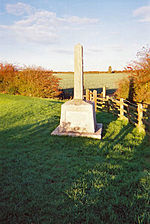Traveling down the River Witham in its final run towards the sea you will come to the seaport town of Boston. Once, in 1205, Boston was the second largest seaport in England with only the port of London being larger. For over 800 years Boston has stood at the mouth of the River Witham and given rest to those who are returning and inspiration to those departing.
The magnificent tower of the parish church, St. Botolph's Church, can be seen for miles. Known, ironically, as "The Stump", the tower is 272 feet high. St. Botolph is England's largest parish church and one might be excused for at first thinking of it as a cathedral. The church was built by the town's guilds to reflect the prosperity of the city and the wool trade that was based there. Thanks to the flat terrain of the Fens, it is said that if you walk the 365 steps to the top of the tower you can catch a glimpse of Lincoln, 32 miles away. I took them at their word. :-)
A bit of history here linking the old world to the new:
Because of it's thriving trade with Europe, Boston was exposed to ideas that were popular on the continent. One such idea was Calvinism, based on the teachings of John Calvin. Calvinism had a strong influence on the religious beliefs and religious practices of the residents of Boston and the surrounding area. In 1607 a group of pilgrims from nearby Nottinghamshire, led by William Brewster and William Bradford, unwilling to accept the practices of the Anglican church, attempted to escape to the Netherlands from Boston. Since emigration without official permission was illegal, they were arrested and jailed. Most were released quickly and the following year successfully emigrated to the Netherlands. In 1620, several of these were among the pilgrims who set sail on the Mayflower.
In 1612 John Cotton became the Vicar of St Botolph's church in Boston and, although viewed suspiciously by the Church of England for his non-conformist preaching, was responsible for a large increase in Church attendance. However, he also encouraged those who disliked the lack of religious freedom in England to join the Massachusetts Bay Colony. Still later, in 1630, Reverand Cotton helped to found the city of Boston, Massachusetts and was instrumental in its naming. He eventually emigrated himself in 1633.
The name Boston originated to honor Saint Botolph, the patron saint of travelers, and is thought to be a contraction of St Botolph's town or of St Botolph's stone. Thus, the historic St. Botolph's Church and the cities of Boston have shared an honored link for centuries. The strength of that link can be seen by the financing of the repairs to St. Boltoph's Church by the citizens of Boston, Massachusetts.
A monument to the Pilgrim Fathers to be found in the city of Boston, Lincolnshire, UK.


No comments:
Post a Comment